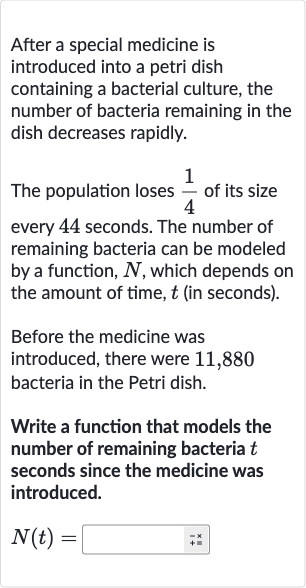AI tutor
Welcome to Bytelearn!
Let’s check out your problem:

After a special medicine is introduced into a petri dish containing a bacterial culture, the number of bacteria remaining in the dish decreases rapidly.The population loses of its size every seconds. The number of remaining bacteria can be modeled by a function, , which depends on the amount of time, (in seconds).Before the medicine was introduced, there were , bacteria in the Petri dish.Write a function that models the number of remaining bacteria seconds since the medicine was introduced.
Full solution
Q. After a special medicine is introduced into a petri dish containing a bacterial culture, the number of bacteria remaining in the dish decreases rapidly.The population loses of its size every seconds. The number of remaining bacteria can be modeled by a function, , which depends on the amount of time, (in seconds).Before the medicine was introduced, there were , bacteria in the Petri dish.Write a function that models the number of remaining bacteria seconds since the medicine was introduced.
- Identify initial amount and rate: Identify the initial amount of bacteria and the rate of decrease.The initial amount of bacteria is given as . The bacteria population decreases by of its size every seconds, which means the remaining fraction of the population after each decrease is (since ).
- Determine decay factor: Determine the decay factor . The decay factor is the fraction of the population that remains after each time interval. In this case, every seconds, the population retains of its size. Therefore, .
- Write exponential decay function: Write the exponential decay function.The general form of an exponential decay function is , where is the number of bacteria at time , is the initial amount, is the decay factor, and is the time in the same units as the decay interval. However, since the decay happens every seconds, we need to adjust the exponent to reflect the number of -second intervals that have passed. This means we divide by to get the number of intervals.
- Write final function: Write the final function.Using the values from the previous steps, the function that models the number of remaining bacteria seconds since the medicine was introduced is:
More problems from Write exponential functions: word problems
QuestionGet tutor help
QuestionGet tutor help
QuestionGet tutor help
QuestionGet tutor help
QuestionGet tutor help
QuestionGet tutor help
QuestionGet tutor help
QuestionGet tutor help
QuestionGet tutor help
